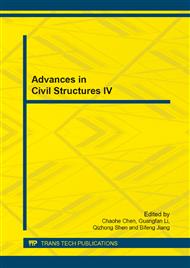p.1012
p.1016
p.1020
p.1024
p.1028
p.1032
p.1037
p.1042
p.1047
Structural Damage Detection Based on Ridge Estimation Method
Abstract:
In order to identify structural damage locations and extent, a method based on ridge estimation and modal strain energy is presented in this paper. First, structural modal strain energy is given and a modal strain energy sensitivity damage equation is obtained. Then, considering the TikhonovTT regularization theoryTT, a ridge estimation method is proposed to solve the damage equation and ridge parameter of the method is optimized. Simulation results demonstrate that the proposed damage detection method based on ridge estimation and modal strain energy can identify structural damage locations and extent with good accuracy.
Info:
Periodical:
Pages:
1028-1031
Citation:
Online since:
July 2014
Authors:
Keywords:
Price:
Сopyright:
© 2014 Trans Tech Publications Ltd. All Rights Reserved
Share:
Citation:


